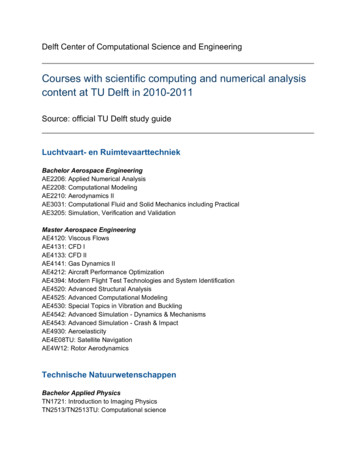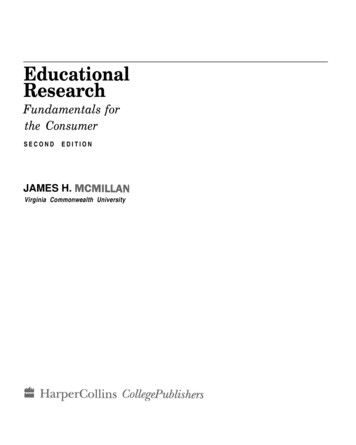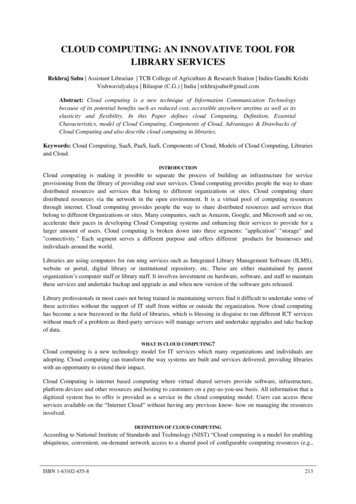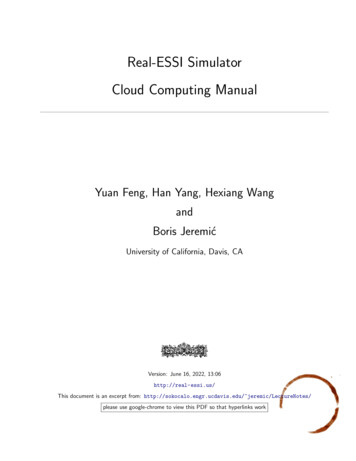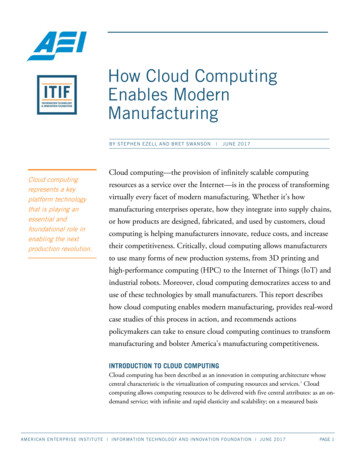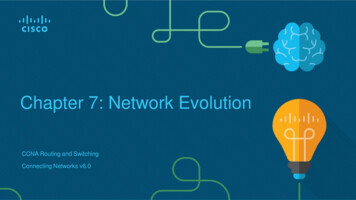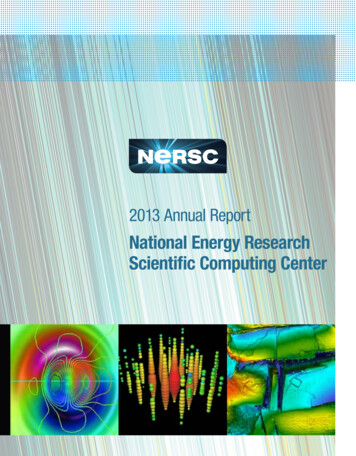
Transcription
2013 Annual ReportNational Energy ResearchScientific Computing Center
2013 Annual ReportNational Energy ResearchScientific Computing CenterErnest Orlando Lawrence Berkeley National Laboratory1 Cyclotron Road, Berkeley, CA 94720-8148This work was supported by the Director, Office of Science, Office of Advanced Scientific Computing Research of the U.S. Departmentof Energy under Contract No. DE-AC02-05CH11231.Cover Image Credits:front cover, left to right: Linda Sugiyama, Massachusetts Institute of Technology; IceCube Collaboration; David Trebotich,Lawrence Berkeley National Laboratory. back cover, left to right: Menghao Wu, Virginia Commonwealth University;Planck Collaboration; James Sethian, Robert Saye, Lawrence Berkeley National Laboratory, UC Berkeley
2 NERSC ANNUAL REPORT 2013Table of Contents4The Year in Perspective6Research News812141618202224262830323436384042444648Edison Opens New Doors for Early UsersIceCube IDs ‘Bert’ and ‘Ernie’Spotting Hotspot VolcanoesUnlocking the Secrets of Solar Wind TurbulenceWith Nanoparticles, Slower May Be BetterCalculations Confirm 150 Years of Global Land WarmingPhysicists ID New Molecules With Unique FeaturesWhy Foams Foam and Bubbles PopReading the Cosmic Writing on the WallThe Life and Times of Massive StarsThinnest Solar Cells Ever?Taming Plasma Fusion SnakesGetting More from Natural Gas ReservesPolicing Air Quality in CaliforniaTurning Greenhouse Gases into GoldHelping a Catalyst Reach its Full PotentialHow Cells Interact With Their SurroundingsAn Inside Look at an MOF in ActionNISE Program AwardsNERSC Users’ Awards and Recognition58NERSC Center News585959606061Jeff Broughton Promoted to NERSC Division Deputy for OperationsKatie Antypas Leads NERSC Services DepartmentNick Wright Tapped to Head Advanced Technologies GroupRichard Gerber New NERSC User Services Group LeadNERSC Helps Launch DesignForward Exascale PartnershipPetascale Post-Docs Project an HPC Success Story
Table of Contents 364Computational Systems and Facilities6465666768Navigating the Road to NERSC-8NERSC Users Take Edison For a Test DriveComputational Research and Theory Facility Nears CompletionGlobal Scratch Gets an UpgradeNERSC Now Connecting All Science at 100 Gbps69Innovations697074Preparing for Exascale: Energy EfficiencyPreparing for Exascale: New Computational ModelsImproving the User Experience82User Support and Outreach8384848485Library Performance Improvements on EdisonDarshan I/O Performance Monitoring SoftwareBerkeley GW Coding WorkshopSciDB Testbed ProjectNERSC Supports DARPA Mission Partners on Edison86Research and Development by NERSC Staff96Appendix A: NERSC User Statistics98Appendix B: NERSC Users Group Executive Committee99Appendix C: Office of Advanced Scientific Computing Research100Appendix D: Acronyms and Abbreviations
4 NERSC ANNUAL REPORT 2013The Year In PerspectiveMy first full year as Director of NERSC has been an excitingand gratifying one. I have endeavored to keep NERSC focused onenabling scientific discovery, while evaluating and overseeing theimplementation of new technologies that are improving NERSCsystems and infrastructure, and new service innovations designedto meet the increasingly complex needs of our scientific users.As the high-end scientific computing facility for the Department ofEnergy’s Office of Science (DOE SC), we serve the computationalscience needs of DOE SC’s six program offices. With more than5,000 users from universities, national laboratories and industry,we support the largest and most diverse research community of anycomputing facility within the DOE complex. NERSC provideslarge-scale, state-of-the-art computing for DOE’s unclassifiedresearch programs in alternative energy sources, climate change,energy efficiency, environmental science and other fundamentalscience areas.NERSC’s primary mission is to accelerate scientific discoveryat the DOE SC through high performance computing and dataanalysis. In 2013 we provided 1.25 billion computer hours to our users, and taking advantage of unchargedtime on NERSC’s newest supercomputing system they were able to use 2.1 billion hours. 2013 proved tobe a productive year for scientific discovery at the center; our users published 1,977 refereed papers and 18journal cover stories based on computations performed at NERSC. In addition, Martin Karplus of HarvardUniversity, who has been computing at NERSC since 1998, was awarded a Nobel Prize in Chemistry forhis contributions to the field of computational chemistry.Several other NERSC projects were also honored in 2013. In December, Physics World’s “Breakthroughof the Year” went to the IceCube South Pole Neutrino Observatory for making the first observations ofhigh-energy cosmic neutrinos, an achievement enabled in part by NERSC resources. In fact, NERSC wasinvolved in three of Physics World’s top 10 breakthroughs of 2013— t he other two being the European SpaceAgency’s Planck space telescope, which revealed new information about the age and composition of theuniverse, and the South Pole Telescope, which made the first detection of a subtle twist in light from theCosmic Microwave Background. The Planck Collaboration also received the NERSC Achievement Awardfor High-Impact Science.In addition, WIRED magazine listed two NERSC-related projects as its top science discoveries of 2013: theIceCube results and the final findings of the NASA Kepler space telescope that one in five Sun-like stars in ourgalaxy has an Earth-sized planet orbiting it at a habitable distance. And the Materials Project, one ofour most popular science gateways, was featured as a “world changing idea” in a November 2013 ScientificAmerican cover story, “How Supercomputers Will Yield a Golden Age of Materials Science.”
The Year in Perspective 5We also continued our close collaboration with the Joint Genome Institute, which has given NERSC importantinsights into the needs of DOE experimental facilities. Our JGI database now has over 3 billion genes, andJGI scientists can process 100 million genes in a few days. We are also working closely with the Advanced LightSource (ALS) at Berkeley Lab and deployed a prototype data pipeline that automatically transfers data from ALSto NERSC for analysis and sharing. We successfully completed a data pilot with the SLAC National AcceleratorLaboratory in which we processed a 150 terabyte dataset at NERSC from the Linac Coherent Light Source.We are looking forward to expanding these and other ongoing collaborations in 2014 and beyond.Another highlight of 2013 was the installation of our newest supercomputing platform, a Cray XC30 systemnamed Edison in honor of American inventor Thomas Alva Edison. Scientists from around the globe eagerlyqueued up to take advantage of the new supercomputer’s capabilities. Edison was the first Cray supercomputerwith Intel processors, a new Aries interconnect and a dragonfly topology. The system was designed to optimizedata motion—the primary bottleneck for many of our applications—as opposed to peak speed. It has veryhigh memory bandwidth, interconnect speed and bisection bandwidth. In addition, each node has twice thememory of many leading systems. This combination of fast data motion and large memory per node makeit well suited for both our traditional HPC workload and newly emerging data intensive applications.Other technical highlights in 2013 included the upgrade of our border network to 100 gigabits per secondand the increase in performance to up to 80 gigabytes per second in the globally accessible scratch file system.Innovations in 2013 included achieving high energy efficiency for running Edison, introducing new toolsto support data-intensive science and preparing our users for the transition to exascale.As always, user support is a high priority at NERSC. In 2013 our efforts to enhance NERSC’s user supportservices continued to prove effective: The “Overall Satisfaction with NERSC” score for 2013 was thesecond-highest ever recorded in the 15 years our user survey has been in its current form. User supporthighlights included working with Cray to improve library performance on Edison, providing the resultsof I/O monitoring to help users diagnose and fix I/O performance issues, assisting users in transitioningto energy-efficient manycore architectures, providing a new parallel scientific database (SciDB) to usersand helping users create new science portals to enhance collaboration and team science.The demands from larger and more detailed simulations, massive numbers of simulations and the explosionin the size and number of experimental datasets mean there is no end in sight to the need for NERSCresources. Overcoming the challenges of energy efficiency, concurrency, memory balance and resiliencewill require the creativity and expertise of the NERSC staff and greater collaborations with vendor partners,the user community and other supercomputing centers. Staying ahead of technology, anticipating problemsand developing solutions that are effective for the broad science workload are part of NERSC’s culture.As we look ahead to 2014—the 40th anniversary of NERSC—we are excited about our forthcoming move intothe new Computational Research and Theory (CRT) facility on the main Berkeley Lab site and preparing todeploy our next supercomputer, NERSC-8, which is named Cori in honor of Gerty Cori, the first Amercianwoman to win a Nobel Prize in science. CRT is a highly energy-efficient, state-of-the-art computing facilitythat will provide over 40 megawatts of power and 30,000 square feet of space for computing and storage.In 2013 we released the request for proposals for NERSC-8 in collaboration with the Alliance for Computingat the Extreme-Scale (ACES), a partnership between Los Alamos and Sandia National Laboratories. ACESis planning to deploy their next supercomputer, Trinity, in the same time frame as Cori. NERSC has beenworking with ACES for several years—we deployed Hopper at the same time ACES installed a very similarsystem, Cielo—and we look forward to continuing this very successful collaboration.With all the advanced technologies we deploy, it is still people who make the difference. As always, I am gratefulto our DOE SC sponsors for their continued support, our users for the science they produce using NERSCresources and the NERSC staff who make NERSC such a successful high performance computing center.Sudip DosanjhNERSC Division Director
6ResearchNews
Research News 7The National Energy Research Scientific Computing Center (NERSC)is the high-end scientific computing facility for the Department ofEnergy’s Office of Science (DOE SC). With more than 5,000 usersfrom universities, national laboratories and industry, NERSC supportsthe largest and most diverse research community of any computingfacility within the DOE complex.NERSC provides large-scale, state-of-the-art computing for DOE’sunclassified research programs in alternative energy sources, climatechange, energy efficiency, environmental science and otherfundamental science areas within the DOE mission.NERSC’s primary mission is to accelerate scientific discovery at theDOE SC through high performance computing and data analysis. In2013, our users reported 1,977 refereed papers and 18 journal coverstories based on computations performed at NERSC.This section presents a selection of research highlights showing thebreadth of science supported by the center.
8 NERSC ANNUAL REPORT 2013Edison Opens New Doorsfor Early UsersFrom improving carbon sequestration models to creatingvirtual universes, NERSC’s newest supercomputer is a hit“The memorybandwidth makesa huge differencein performance forour code.”before any supercomputer is accepted at nersc, the system is rigorously tested as scientistsare invited to put the system through its paces during an “early science” phase. While the main aim of thisperiod is to test the new system, many scientists are able to use the time to significantly advance their work.Here’s a look at the work NERSC’s new Edison Cray XC30 helped some early users accomplish in 2013.The Fate of Sequestered CO2David Trebotich is modeling the effects of sequestering carbon dioxide (CO2) deep underground. Theaim is to better understand the physical and chemical interactions between CO2 , rocks and the minute,saline-filled pores through which the gas migrates. This information will help scientists understandhow much we can rely on geologic sequestration as a means of reducing greenhouse gas emissions,which cause climate change.Unlike today’s large-scale models, which are unable to resolve microscale features, Trebotich models thephysical and chemical reactions happening at resolutions of hundreds of nanometers to tens of microns.His simulations cover only a tiny area—a tube just a millimeter wide and not even a centimeter long—but in exquisitely fine detail.“We’re definitely dealing with big data and extreme computing,” said Trebotich, a computational scientistin Berkeley Lab’s Computational Research Division. “The code Chombo-Crunch generates datasets ofone terabyte for just a single, 100-microsecond time-step, and we need to do 16 seconds of that to matcha ‘flow-through’ experiment.” Carried out by the Energy Frontier Research Center for Nanoscale Controlof Geologic CO2 , the experiment captured effluent concentrations due to injecting a solution of dissolvedcarbon dioxide through a tube of crushed calcite.
Research News 9The fine detail of this simulation—which showscomputed pH on calcite grains at 1 micronresolution—is necessary to better understand whathappens when the greenhouse gas carbon dioxideis injected underground rather than being releasedinto the atmosphere to exacerbate climate change.david trebotich, lawrence berkeley nationallaboratoryEdison’s high memory-per-node architecturemeans that more of each calculation (andthe resulting temporary data) can be storedclose to the processors working on it.Trebotich was invited to run his codes tohelp test the machine and his simulationsran 2.5 times faster than on Hopper, aCray XE6 and the previous flagship system,reducing the time it takes him to get asolution from months to just weeks.“The memory bandwidth makes a hugedifference in performance for our code,”Trebotich said.The aim is to eventually merge such finelydetailed modeling results with large-scalesimulations for more accurate models.Trebotich is also working on extending hissimulations to shale gas extraction usinghydraulic fracturing. The code frameworkcould also be used for other energyapplications, such as electrochemicaltransport in batteries.Better Combustion for New FuelsJackie Chen and her research team at SandiaNational Laboratories are using Edisonto investigate how to improve combustionusing new engine designs and fuels such asbiodiesel, hydrogen-rich “syngas” from coalgasification and alcohols like ethanol. Hergroup models the behavior of burning fuels bysimulating some of the underlying chemicaland mixing conditions found in thesecombustion engines in simple laboratoryconfigurations, using a direct numericalsimulation code developed at Sandia.During Edison’s early science period,Chen and colleagues modeled hydrogenand oxygen mixing and burning in atransverse jet configuration commonlyemployed by gas turbine combustors inaircraft engines and industrial powerplants. Their simulations were performedin tandem with experimentalists tounderstand the complex flow field affectedby reaction and how it manifests itself ininstabilities. This information is criticalto understanding both the safety andperformance of the device.The team was able to run their directnumerical simulation code, S3D, on100,000 processors at once on Edisonand saw a four- to five-fold performanceimprovement over Hopper, Chen said.“In the end, what really matters isn’t thetechnical specifications of a system,” saidChen. “What really matters is the scienceyou can do with it, and on that count,Edison is off to a promising start.”Our Universe: The Big PictureZarija Lukic, a cosmologist with BerkeleyLab’s Computational Cosmology Center (C3),used Edison to model mega-parsecs of spacein an attempt to understand the large-scalestructure of the universe.
10 NERSC ANNUAL REPORT 2013Since we can’t step outside our own universeto see its structure, cosmologists like Lukicexamine the light from distant quasars andother bright light sources for clues. Whenlight from these quasars passes throughclouds of hydrogen, the gas leaves adistinctive pattern in the light’s spectrum.By studying these patterns (which look likeclusters of squiggles called a Lyman alphaforest), scientists can better understandwhat lies between us and the light source,revealing the process of structure formationin the universe.Researchers use a variety of possiblecosmological models, calculating for eachthe interplay between dark energy, darkmatter and the baryons that flow intogravity wells to become stars and galaxies.Cosmologists can then compare these virtualuniverses with real observations. Using theNyx code developed by Berkeley Lab’s Centerfor Computational Sciences and Engineering,Lukic and colleagues are able to create virtual“what-if” universes to help cosmologists fillin the blanks in their observations.“The ultimate goal is to find a single physicalmodel that fits not just Lyman alpha forestobservations but all the data we have aboutthe nature of matter and the universe, fromcosmic microwave background measurementsto results from experiments like the LargeHadron Collider,” Lukic said.Working with 2 million early hours on Edison,Lukic and collaborators performed one ofthe largest Lyman alpha forest simulationsto date: the equivalent of a cube measuring370 million light years on each side.“With Nyx on Edison we’re able—for the firsttime—to get to volumes of space large enoughand with resolution fine enough to createmodels that aren’t thrown off by numericalbiases,” he said. Lukic expects his work onEdison will become “the gold standard forLyman alpha forest simulations.”Large-scale simulations such as these willbe key to interpreting the data from manyupcoming observational missions, includingThis volume rendering shows the reactivehydrogen/air jet in crossflow in a combustionsimulation. hongfengyu, university ofnebraskaH20TH2
Research News 11the Dark Energy Spectroscopic Instrument,he added.Growing Graphene and Carbon NanotubesVasilii Artyukhov, a post-doctoral researcherin materials science and nanoengineeringat Rice University, used 5 million processorhours during Edison’s testing phase tosimulate how graphene and carbon nanotubesare “grown” on metal substrates usingchemical vapor deposition.Graphene (one-atom thick sheets of graphite)and carbon nanotubes (essentially graphenegrown in tubes) are considered “wondermaterials” because they are light but strongand electrically conductive, among otherproperties. These nanomaterials offer theprospects of vehicles that use less energy;thin, flexible solar cells; and more efficientbatteries—that is, if they can be producedon an industrial scale.Today’s methods for growing grapheneoften produce a mish-mash of nanotubeswith different properties; for instance,semiconducting types are useful forelectronics and metallic types forhigh-current conduits. For structuralpurposes the type is less important thanthe length. That’s why the group is alsoinvestigating how to grow longer tubeson a large scale.For Artyukhov’s purposes, Edison’s fastconnections between processor nodes hasallowed him to run his code on twice asmany processors at speeds twice as fast asbefore. The Rice University researcher isalso using molecular dynamics codes,“which aren’t as computationally demanding,but because Edison is so large, you can runmany of them concurrently,” he said.Using the Nyx code on Edison, scientistswere able to run the largest simulation of its kind(370 million light years on each side) showingneutral hydrogen in the large-scale structureof the universe. The blue webbing representsgas responsible for Lyman-alpha forest signals.The yellow are regions of higher density, wheregalaxy formation takes place.casey stark,lawrence berkeley national laboratory
12 NERSC ANNUAL REPORT 2013IceCube IDs ‘Bert’ and ‘Ernie’NERSC computers essential for finding neutrino eventin timely manner at South Pole“The large amountof computingresources at NERSC. was essentialto finding theseneutrino events in atimely manner.”data being collected at “icecube ,” the neutrino observatory buried in the South Pole ice,nd analyzed at NERSC is helping scientists better understand cosmic particle accelerators.In 2013, the IceCube Collaboration announced that it had observed 28 extremely high-energyevents that constitute the first solid evidence for astrophysical neutrinos from outside our solarystem, according to Spencer Klein, a senior scientist with Berkeley Lab and a long-time memberof the IceCube Collaboration. These 28 events include two of the highest energy neutrinos everreported, dubbed Bert and Ernie.NERSC’s supercomputers were used to sift out neutrino signals from cosmic “noise” in the IceCubeobservations, which were published in the journal Science in November 2013.“The large amount of computing resources at NERSC allowed me to set up my simulations and run themright away, which was essential to finding these neutrino events in a timely manner,” said Lisa Gerhardt,who at the time of her discovery was with Berkeley Lab’s Nuclear Science Division and is now with NERSC.These results provide experimental confirmation that something is accelerating particles to energies above50 trillion electron volts (TeV) and, in the cases of Bert and Ernie, exceeding one quadrillion electron volts(PeV). While not telling scientists what cosmic accelerators are or where they’re located, the IceCube resultsdo provide them with a compass that can help guide them to the answers.Cosmic accelerators have announced their presence through the rare ultra-high energy version of cosmicrays, which, despite the name, are electrically charged particles. It is known that ultra-high energy cosmicrays originate from beyond our solar system, but the electrical charge they carry bends their flight pathsPROJECT TITLENERSC PILEAD INSTITUTIONNERSC RESOURCES USEDSimulation and Analysisfor IceCubeChang Hyon HasLawrence BerkeleyNational LaboratoryCarver, Dirac, PDSF
Research News 13This event display shows “Ernie,” one of twoneutrino events discovered at IceCube whoseenergies exceeded one petaelectronvolt (PeV). Thecolors show when the light arrived, with reds beingthe earliest, succeeded by yellows, greens andblues. The size of the circle indicates the number ofphotons observed.as they pass through interstellar magneticfields, making it impossible to determinewhere in the universe they originated.However, as cosmic ray protons and nuclei areaccelerated, they interact with gas and light,resulting in the emission of neutrinos withenergies proportional to the energies of thecosmic rays that produced them. Electricallyneutral and nearly massless, neutrinos are likephantoms that travel through space in astraight line from their point of origin, passingthrough virtually everything in their pathwithout being affected.The IceCube observatory consists of 5,160basketball-sized detectors called DigitalOptical Modules (DOMs), which wereconceived and largely designed at BerkeleyLab. The DOMS are suspended along 86strings embedded in a cubic kilometer ofclear ice starting one and a half kilometersbeneath the Antarctic surface. Out of thetrillions of neutrinos that pass through theice each day, a couple of hundred will collideicecube collaborationwith oxygen nuclei, yielding the bluelight of Cherenkov radiation that IceCube’sDOMs detect.The 28 high-energy neutrinos reported inScience by the IceCube Collaboration werefound in data collected from May 2010 toMay 2012. In analyzing more recent data,researchers discovered another event that wasalmost double the energy of Bert and Ernie,dubbed “Big Bird.”As to the identity of the mysterious cosmicaccelerators, Klein thinks these early resultsfrom IceCube favor active galactic nuclei, theenormous particle jets ejected by a black holeafter it swallows a star.“The 28 events being reported are diffuseand do not point back to a source,” Kleinsaid, “but the big picture tends to suggestactive galactic nuclei as the leading contenderwith the second leading contender beingsomething we haven’t even thought of yet.”DOE PROGRAM OFFICEFULL STORYPUBLICATIONNP—Nuclear ia-icecube/Ice Cube Collaboration, “Evidence forHigh-Energy Extraterrestrial Neutrinos atthe IceCube Detector,” Science, November22, 2013, 342(6161), doi: 10.1126/science.1242856
14 NERSC ANNUAL REPORT 2013Spotting Hotspot VolcanoesNERSC computers helped scientists detect previouslyunknown channels of slow-moving seismic waves in Earth’supper mantle“Without thesenew techniques,the study’s analysiswould have takenabout 19 yearsto compute.”using supercomputers at nersc, scientists have detected previously unknown channels of slow-movingseismic waves in Earth’s upper mantle. This discovery helps to explain how “hotspot volcanoes”—the kind thatgive birth to island chains like Hawaii and Tahiti—come to exist.The researchers found these channels by analyzing seismic wave data from some 200 earthquakes usinghighly accurate computer simulations of how these waves travel through the Earth’s mantle—the layerbetween the planet’s crust and core. These analyses allowed them to make inferences about the structureof convection in the mantle, which is responsible for carrying heat from the planet’s interior to the surfaceto create hotspot volcanoes.“We now have a clearer picture that can help us understand the ‘plumbing’ of Earth’s mantle responsiblefor hotspot volcano islands like Tahiti and Samoa,” said Scott French, a University of California at Berkeleygraduate student and lead author on the study, which was published in the journal Science.Unlike volcanoes that emerge from collision zones between tectonic plates, hotspot volcanoes form in themiddle of plates. Geologists hypothesize that mantle plumes—hot jets of material that rise from deep insidethe mantle, perhaps near the core-mantle boundary—supply the heat that feed these mid-plate volcaniceruptions. But that model does not easily explain every hotspot volcano chain or why large swaths of thesea floor are significantly hotter than expected.To learn more about the mantle’s structure and convection, French looked at seismic data from hundredsof earthquakes around the world. These energetic waves travel for long distances below Earth’s surface andare tracked by a global network of seismographs. Because the waves change as they travel through differentmaterials, scientists can gain insights about the structure and composition of the substances beneath thePROJECT TITLENERSC PILEAD INSTITUTIONNERSC RESOURCES USEDGlobal Full-Waveform SeismicTomographyBarbara RomanowiczUC BerkeleyHopper
Research News 15This 3D view of the top 1,000 kilometers ofEarth’s mantle beneath the central Pacific shows therelationship between seismically slow “plumes”and channels imaged in the UC Berkeley study.Green cones on the ocean floor mark islandsassociated with “hotspot” volcanoes, such asHawaii and Tahiti.berkeley seismologicallaboratory, uc berkeleyplanet’s surface by analyzing the alteredwaves. But because they cannot directlyobserve the structures lurking belowEarth’s surface, seismic tomographycan be harder to interpret.“To simulate seismic data for interpretation,people have traditionally used broad layersof approximation because it would havebeen too computationally heavy to run anexact model using numerical simulations,”said French.As a graduate student at UC Berkeley in2010, Vedran Lekic used supercomputersat NERSC to develop a method to accuratelymodel seismic wave data while keepingcomputing time manageable. French recentlyrefined this approach, further improvingthe accuracy of the tomography, whilealso scaling the technique to solve largerproblems. Together, these efforts resultedin higher-resolution images of patternsof convection in the Earth’s mantle.One simulation of one earthquake takes about144 computer processor hours on NERSC’sHopper system, French said, “But we neededto run this simulation for 200 individualearthquakes to get an accurate seismic model.Our model improves with each run.”This tomographic model eventually allowedthe team to find finger-like channels oflow-speed seismic waves traveling in themantle about 120 to 220 miles beneath thesea floor. These channels stretch about 700miles wide and 1,400 miles apart. Seismicwaves typically travel about 2.5 to 3 milesper second at this depth, but waves in thechannels traveled about 4 percent slower.Because higher temperatures slow downseismic waves, scientists inferred thatmaterial in the channels must be hotterthan surrounding material.Without these new techniques, the study’sanalysis would have taken about 19 yearsto compute, Lekic noted.DOE PROGRAM OFFICEFULL lcanoes/Scott French, Vedran Lekic and BarbaraRomanowicz, “Waveform TomographyReveals Channeled Flow at the Base ofthe Oceanic Asthenosphere,” Science,342(6155), 227-230 (2013), doi: 10.1126/science.1241514
16 NERSC ANNUAL REPORT 2013Unlocking the Secrets of SolarWind TurbulenceNERSC resources, visualizations help scientists forecastdestructive space weather“Thesesimulationsopened upa whole newarea of physicsfor us.”as inhabitants of earth, our lives are dominated by weather. Not just in the form of rain and snow fromatmospheric clouds, but also charged particles and magnetic fields generated by the Sun—a phenomeno
queued up to take advantage of the new supercomputer’s capabilities. Edison was the first Cray supercomputer with Intel processors, a new Aries interconnect and a dragonfly topology. The system was designed to optimize data motion—the primary bottleneck for many of our applicatio






